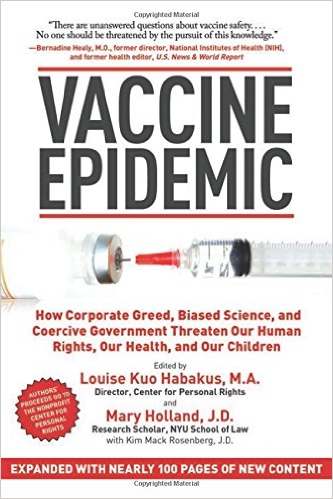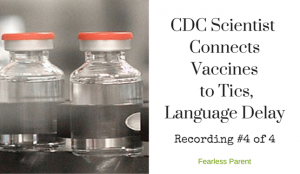In Part One, I covered some lesser known safety issues with the combination measles, mumps & rubella vaccine. Now let’s talk about the company that makes it.
Who’s Merck & Co?
Merck & Co. is a U.S. corporation headquartered in New Jersey and the world’s seventh largest pharmaceutical firm. It was founded in 1891 as the U.S. subsidiary of a German company by the same name. The U.S. confiscated the subsidiary after World War I and established it as an independent company.
In 2014, Merck & Co. reported $42.4 billion in worldwide revenues and $10.3 billion in net income. It ranked #65 on the Fortune 500. Merck Vaccines is a $10.1 billion business. A little over half its sales comes from the following childhood vaccines:
- $1,738,000,000 Gardasil (HPV)
- $1,394,000,000 MMR/ProQuad/Varivax (measles, mumps, rubella, chickenpox)
- $ 765,000,000 Zostavax (shingles)
- $ 746,000,000 Pneumovax 23 (pneumococcal)
- $ 659,000,000 RotaTeq (rotavirus)
The company also makes childhood vaccines for Hepatitis A, Hepatitis B, and Haemophilus influenzae B (Hib).
For Merck, the tsunami of pro-measles vaccine press has been a welcome distraction from some bad news. I’d like to share a few of the big stories that have not gotten the media play they (and we) deserve.
“Investors should avoid this stock”
$42.4 billion sounds pretty good to most of us and Merck’s top brass are well fed — executive compensation is publicly disclosed — but shareholders are unhappy and analysts are not sanguine.
TheStreet.com reported on 2/4/15 “Merck’s Disappointing Forecast Means Investors Should Avoid This Stock“:
Merck… revenue fell more than 7% year over year, missing Wall Street projections by $30 million, and Merck forecast that full-year 2015 revenue would fall more than 5% year over year. For now, investors should avoid this stock.
The pharma patent cliff
VACCINES AS THE GROWTH STRATEGY
The broader context is that the pharmaceutical industry has been reeling. Google “patent cliff” and you’ll read about the long list of chemical and biologic blockbuster drugs invented in the early to late 1990s with scheduled patent expirations rolling off from 2011 to 2019. The pipeline has been “pooping out.”
Merck itself acknowledged this impact in their announcement of 2014 financials:
Full-Year 2014 Worldwide Sales of $42.2 Billion, a Decrease of 4 Percent, Reflecting Unfavorable Impact of Patent Expiries and Divestitures and a 1 Percent Negative Impact From Foreign Exchange [emphasis mine]
FEAR SELLS
There’s been a big, bright spot for pharma in all this bad news, however.
Vaccines.
Recent reports by Markets and Markets and Research and Markets announced:
- the global vaccine market is $33.1 billion in 2014
- it’s expected to reach $58.9 billion by 2019
- for a compound annual growth rate of 11.8%
- with a longer-term outlook to surpass $100 billion by 2025
Wow. That’s one attractive business. Fear sells. Merck loves it. Gardasil was a Hail Mary pass — many lambasted its pull-out-all-the-stops marketing as manipulative and irresponsible — that not only bailed the company out of its Vioxx nightmare but emerged as one of its most profitable products ever. Pfizer is down with vaccines, too. It’s the primary reason Pfizer forked over $68 billion for Wyeth in 2009.
Check out Merck’s development pipeline. Click on “Therapeutic Areas” to narrow the search to vaccines. A new hexavalent combination shot against six diseases — diphtheria, pertussis tetanus, polio, Hib, and Hepatitis B — caught my eye.
BIG PEOPLE NEED SHOTS, TOO
We think about vaccines as mostly for children. Adults should know that we will be targeted for a lot more vaccines. Here’s a recent position paper “National Adult Immunization Plan” by the federal National Vaccine Program Office published on 2/5/15. Check out what they have to say about:
- 2020 “healthy people target levels” by vaccine with separate goals for all adults, healthcare workers, and pregnant women (page 2)
- expanded use of electronic health records and immunization information systems to collect and track data, and facilitate private medical records across state lines (page 13)
- engaging employers and faith-based organizations to promote uptake (pp 15, 22)
Corporations like Merck will jump at opportunities to collaborate to increase market penetration and boost earnings. As an example, Merck is implementing a “vaccine adherence” strategy. It is partnering with an electronic health records company to give clinicians real time data access.
Can we trust Merck?
Merck has a U.S. monopoly on vaccines for measles, mumps, rubella, chickenpox, and shingles. Mainstream media likes to cut vaccine makers slack because of public health, as evidenced by recent coverage in The Atlantic and on Bloomberg. Inquiring about abuse of monopoly power is a valid question but I believe we’re really asking a broader question:
Do we trust Merck and other vaccine makers?
There are a number of issues that must be addressed when we consider this. I’ll raise four:
#1: EXPECT RATIONAL BEHAVIOR
What can we really expect from corporations that enjoy near blanket liability protection courtesy of the 1986 National Childhood Vaccine Injury Act (“1986 Act”)? My colleagues and I have addressed this point in our other work, including the bestselling book Vaccine Epidemic and my recent post: “Vaccination: Is It Time to Pull the Wool From Your Eyes?”
We should not be surprised to know that organizations behave rationally and in the case of corporations, this means behavior to maximize profitability, influence, and control. Childhood vaccines are an exceptionally attractive market:
- Federal government recommends vaccines for virtually all children
- All 50 state governments mandate vaccines as a condition of day care and school admission
- Governments allocate billions of dollars for vaccine development, approval, distribution, and promotion through the NIH, FDA, CDC, state health departments, and a variety of entitlement programs
- Vaccine makers cannot be sued for most liability associated with death and catastrophic injury following vaccination of government recommended vaccines
- Liability protection encourages industry to develop more vaccines and get them on the ACIP childhood schedule
- Liability protection discourages industry from making safer vaccines, whether it’s updating old shots or introducing new technologies that focus on safety
- Liability protection discourages industry from researching potential harms caused by their vaccines
Since the 1986 Act was passed, the U.S. departed from the typical vaccines recommended by our First World peers by adding multiple doses of the following nine vaccines to the childhood schedules, one of which is actually administered on the day of birth:
- 1990 Haemophilus influenzae b
- 1991 Hepatits B
- 1995 Chickenpox
- 1998 Rotavirus
- 2000 Pneumococcal
- 2004 Influenza, Hepatitis A
- 2006 Meningococcal, Human Papillomavirus
I believe that passage of the 1986 Act inadvertently and directly contributed to the epidemic of pediatric chronic illness, including the constellation of medical injuries accompanying neurodevelopmental disorders that we see today.
#2: WHY WAS THE 1986 ACT PASSED?
This is an important question. What led Congress and President Reagan to deliberately bypass the Constitution and remove the right to legal recourse and due process, with the accompanying rights and remedies? It has nothing to do with children’s health and everything to do with:
We gave the pharmaceutical industry preferential treatment to continue making vaccines because we want to support domestic industry that can partner with the Defense Department on various products that might be deemed necessary for national security. Read this CDC article “Vaccines in Civilian Defense Against Bioterrorism” for a peek into some of the issues.
And while we’re on this point, check out the CDC Foundation. Yes, a government agency has its own charity. Some of the richest people and organizations donate money to huge programs for our health and safety. We can get into some of the various ways that this could lead to massive conflicts of interest and potential abuse in another post.
Ben Franklin was right about the need for eternal vigilance. We will trade liberty for a bit of safety every single time.
#3: WHAT ABOUT THAT REVOLVING DOOR?
The “revolving door” is a movement of personnel between roles as legislators and regulators and the industries affected by the legislation and regulation.
Julie Gerberding, MD was director of the CDC from 2002-2009.
- During her tenure, the CDC added four vaccines to the recommended childhood schedule.
- Merck happens to manufacture two of them: Hepatitis A and Gardasil (HPV).
- Gardasil rapidly eclipsed MMR as Merck’s largest and most profitable vaccine product through exceptionally aggressive marketing. It was fast tracked through the FDA after a mere six months of trial research.
- In 2004, whistleblower William Thompson, PhD apparently alerted Gerberding that he would be presenting results relating to statistical association between receipt of MMR vaccine and autism.
After waiting the requisite one year to the day Gerberding was hired as President of Merck Vaccines in January 2010.
In December 2014, she was abruptly transitioned to EVP of Strategic Communications, Global Public Policy, and Population Health. This is a new position that had not existed before.
Check out the career path of Eddy Bresnitz, MD, Merck’s Executive Director of Medical Affairs. In his capacity as New Jersey’s State epidemiologist and deputy commissioner of health, he was responsible for the addition of four new vaccine mandates in 2007, including the first ever mandated flu shot in any jurisdiction in the world (others have since followed suit).
#4: WHAT ABOUT THE MEASLES “EPIDEMIC”?
Who’s behind the orchestrated and relentless media “freak out,” publicizing 133 measles cases in California (out of a population of 39 million)? Let’s share information from the latest Measles Surveillance Report from the California Department of Public Health. As of 3/13/15:
- 40 cases visited Disneyland during the period in question
- 85% were not hospitalized
- 56% were over the age of 20
- 18% were between the ages of 5 to 19
- 20 cases were between the ages of 1 and 4
- 15 cases were under the age of 1
This affected exactly 35 kids from birth to age 4 in CA. Is this an epidemic worthy of removing the right to decline all vaccines not just measles vaccine?
CA health officials said the recent outbreak is likely to have started from a traveler who got measles overseas not an unvaccinated child from highly unvaccinated pockets.
The media did not report that measles vaccine uptake, according to the Centers for Disease Control, is at all time high levels and has actually increased over the last 5 years that have been reported — 2009-2013.
The media did not report that many of those affected by this so-called outbreak were vaccinated, suggesting that vaccine source immunity is defective.
The media did not report that immunity from vaccination wanes over time and itself might pose a public health threat.
The media did not report that persons vaccinated with the MMR might themselves be a threat to the immunocompromised because they carry a live infectious virus, the source of which is the vaccine.
The media did not report that no deaths and few hospitalizations resulted from this false epidemic of measles. Latest reports indicate the outbreak has abated.
The media failed us. Industry spokesman Paul Offit called for “journalism jail” in Forbes, for reporters who cause the public to lose confidence in vaccines, suggesting they are effectively a party to murder.
Yet, for some reason, legislators around the country, in sync with each other, have reacted with panic about what is described as a public health emergency.
Why? Who is orchestrating this campaign? Could it be Merck, the sole US manufacturer of the MMR vaccine, who has liberally distributed money to legislators and other vaccine promoters?
Lots of lawsuits
LIES ABOUT MUMPS VACCINE EFFICACY
As reported in Fierce Vaccines on 9/9/14, two lawsuits claiming Merck lied about the efficacy of its mumps vaccine won’t be going away anytime soon:
A federal judge in Pennsylvania refused to dismiss the suits, filed by a pair of whistleblowers and a group of doctors and payers, and now, they’re on their way to trial… [The judge] ruled that… two former Merck virologists… had sufficiently showed that the company may have misstated the vaccine’s efficacy to the government… And the direct purchasers produced enough evidence to establish that those false statements could have helped give Merck a monopoly… Now, the plaintiffs will have to prove their cases at trial.
$100 MILLION LAWSUIT ALLEGES “BOYS CLUB” ATMOSPHERE
As reported in the Star Ledger on 10/23/14, a federal judge turned back an effort by Merck lawyers to dismiss a $100 million lawsuit filed by five female employees alleging employment discrimination.
“THE COST OF DOING BUSINESS”
Like many of its pharma peers, Merck has paid out billions to settle lawsuits for marketing and other abuses. The ill-gotten profits far exceed financial penalties, causing industry watchers to comment that lawsuits are merely another line item in the budget… just an expected cost of doing business.
Drugwatch.com reports that Merck currently faces lawsuits over several products, including Fosamax, Januvia, NuvaRing and Propecia. Its most (in)famous case, however, is the Vioxx scandal. It took Merck less than one year to earn back the $4.85 billion it agreed to pay Vioxx plaintiffs. (Read All the Justice Money Can Buy – Corporate Greed on Trial.)
USA Today reported on 2/14/13 that, while denying wrongdoing, Merck agreed to settle two significant class-action lawsuits alleging it delayed negative study results for two years. It paid $688 million and took a charge of nearly a half-billion dollars against earnings.
And so it continues.
***
Informed consent
Informed consent is the international human rights standard for the practice of ethical medicine as upheld by the 2005 Universal Declaration on BIoethics and Human Rights:
Any preventive, diagnostic and therapeutic medical intervention is only to be carried out with the prior, free and informed consent of the person concerned, based on adequate information.
There is no carve out for vaccination.
The U.S. was not one of the 192 signatories of the above document. Most parents are dismayed to learn that “There is no federal requirement for informed consent relating to immunization.” [CDC, Immunization Managers]
If you want prior, free and informed consent to vaccination, you will need to give it to yourself.
Read the first installment in this series: (Un) Informed Consent: A Few Things Parents Don’t Know About the Measles, Mumps & Rubella Vaccine, Part 1
Like and follow us on Facebook and Twitter. Sign up here.
© 2015 Fearless Parent
 Louise is grateful to be part of a community of fearless parents who are getting it done and reaching out to others. Join us!
Louise is grateful to be part of a community of fearless parents who are getting it done and reaching out to others. Join us!













I am grateful for the thorough research on this important topic. The disclosures, however, are nauseating and seemingly inescapable. How can individuals respond?
First and foremost, we need to know that no one will give us informed consent on vaccination. We have to get it for ourselves.
Second, expect that Merck will behave in a rational manner. If they fear brand damage, they’ll make changes. We must vote with our wallets and with our feet.
Third, it may feel like “truth,” but know that much of the literature you see in hospitals, pharmacies, doctors’ offices, and in the mainstream media is industry-promoted propaganda.
Find community-based support with likeminded parents, professionals, and advocates. Attend events. Keep in touch with us here and on social media.
Thank you…everyone in California is so afraid of measles yet its only the vaccine that can kill get the word out Amen
I am fascinated by the fact that the US is not a signator of the UNESCO human rights declaration on informed consent! I checked the link but could not find a list of the signatories. Can you please point me to that?
Louise, although the Federal Gov’t may not subscribe to informed consent, the American Medical Association does. All doctors take an oath, which includes:
“The patient has the right to make decisions regarding the health care that is recommended by his or her physician. Accordingly, patients may accept or refuse any recommended medical treatment.”
http://www.ama-assn.org/ama/pub/physician-resources/medical-ethics/code-medical-ethics/opinion1001.page?
Thanks Louise for another well written, well referenced, very informative article!
Since most people get very little, or very “selective” information from their health care professionals, I’m not really surprise that there is no federal requirement for informed consent in the U.S., however, It is disturbing to think that the U.S. did not sign the 2005 document that would have made it a requirement.
Thank you, Ken, for your comment and the AMA link, advising that doctors do take an oath in support of informed consent. It’s just sad that more doctors don’t honor it!
https://www.facebook.com/notes/jeff-welch/my-lettercomment-on-naip-to-national-vaccine-program-office/10153141719882726
Polish translation here at Prawda O Szczepionkach: http://prawdaoszczepionkach.pl/(nie)swiadoma-zgoda–czesc-2–szczepionka-mmr–co-sie-dzieje-z-firma-merck,43,146.htm
Great article! Thanks for helping to get the word out there. The public is so mislead. It’s frustrating. I feel like I should continue to refuse vaccinations, but this will mean that I have to homeschool my child. I really don’t want to do that, but I don’t see any other option. How can I give him a vaccine that I know is toxic? He’s entering Kindergarten in 2017.